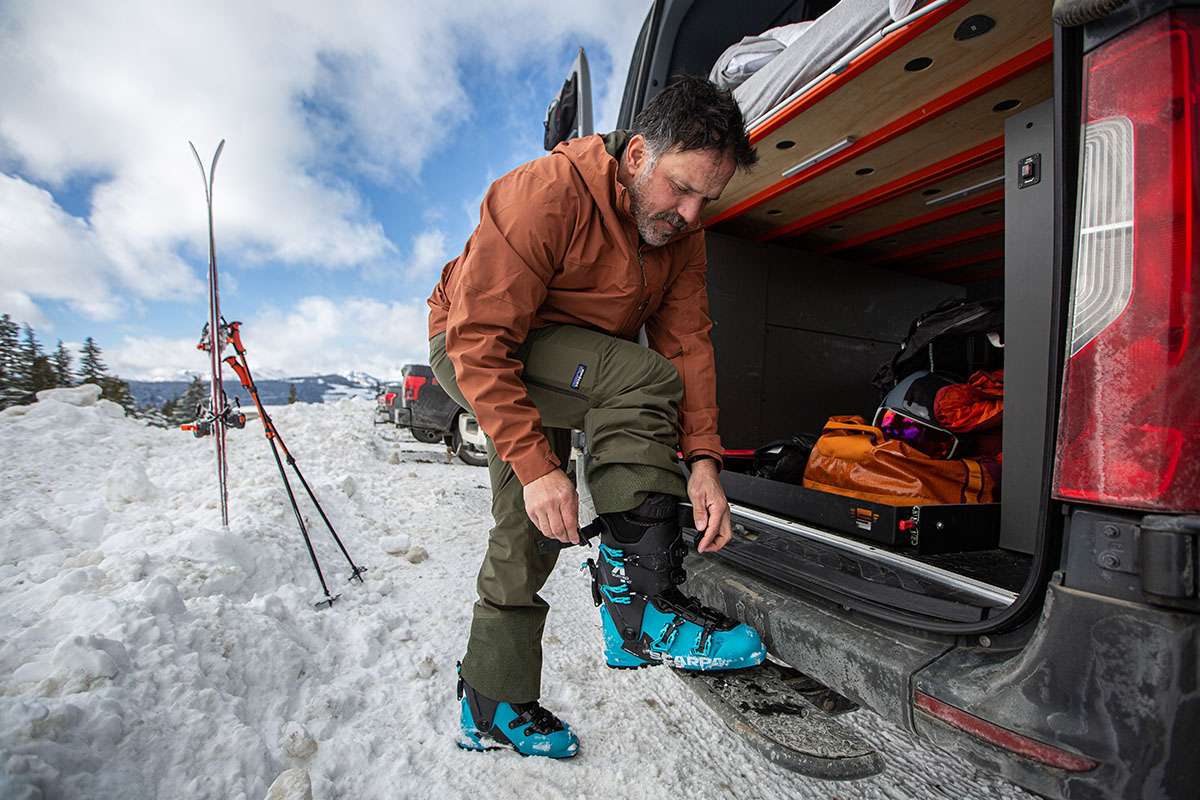
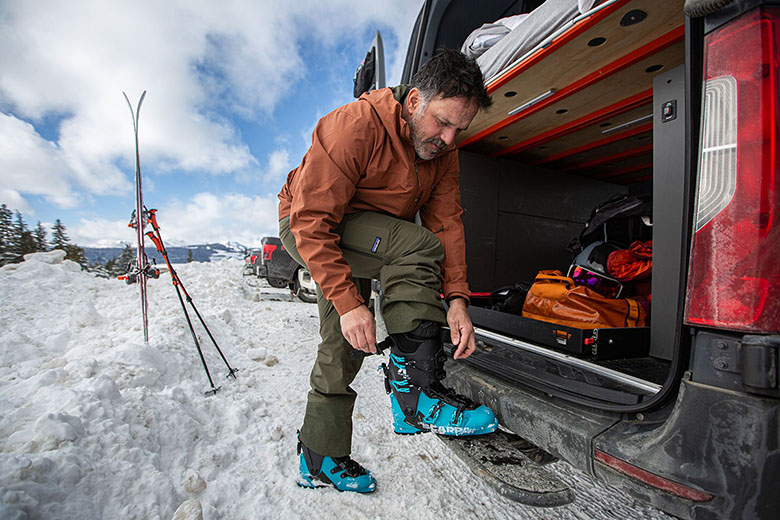
Price: $399
Waterproofing: 2L Gore-Tex
Weight: 1 lb. 10.2 oz. (men’s)
What we like: Top-notch durability and reliable protection in a good-looking and sustainably built package.
What we don’t: Expensive for a 2-layer design, relatively heavy, and Velcro waist adjustments can feel abrasive against the skin.
See the Men's Storm Shift Pants See the Women's Storm Shift Pants
Patagonia is known for their keen attention to detail and strong sustainability focus, and the Storm Shift ski kit is the embodiment of that ethos. We put the men’s Storm Shift Pants through an unseasonably wet and windy winter in British Columbia (even by B.C. standards) and had a lot of positive feedback: The pants are easy to trust thanks to their proven Gore-Tex build, highly durable with a thick shell fabric and quality components, and both stylish and sustainably built. You do pay a premium at $399, and the pants are too heavy and bulky for backcountry use, but resort riders will find them largely uncompromised. Below we break down our experiences with the Storm Shift Pants. To see how they stack up to the competition, see our article on the best ski pants. And to complete your kit, we’ve also tested and reviewed the matching Storm Shift Jacket.
Last winter was a particularly gnarly one in British Columbia, and the Patagonia Storm Shift Pants handled the challenging conditions with aplomb. For waterproofing, Patagonia opted for a thick 2-layer Gore-Tex construction with a durable water repellent (DWR) finish that has deftly fended off snow, rain, and strong winds. For reference, the season had a lot in store for me: Highlights included getting stuck on a chairlift in blustery weather with freezing rain coming down, sitting in the snow for 30 minutes trying to fix a binding, and sliding down a ski hill on my butt when said binding couldn’t be repaired. Through it all, the Storm Shift held up with no issues. The feature set is nicely executed, too, including internal gaiters to seal out snow at the ankles, trustworthy watertight zippers (plus zipper “garages” on the pockets for added assurance), and a webbing loop at the rear to attach to any of Patagonia’s ski jackets. Added up, I have no concerns about the Storm Shift’s protection and consider it a very trustworthy design.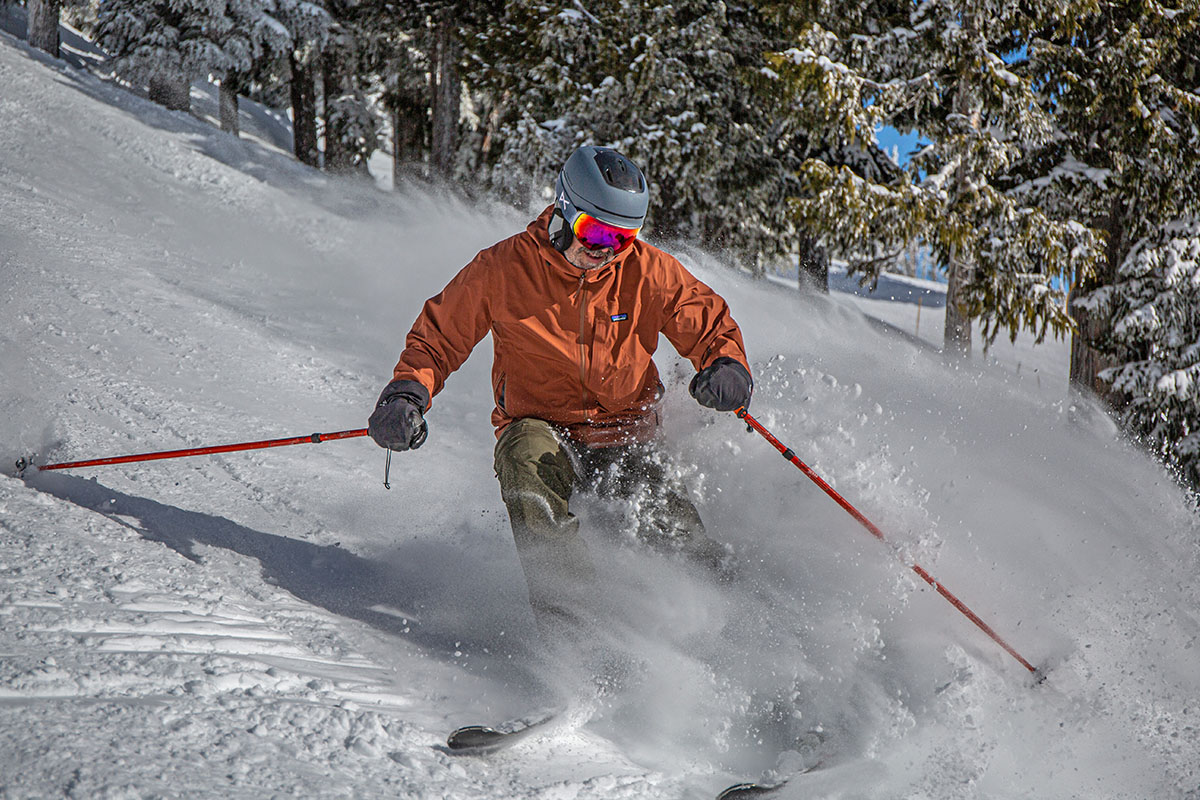
When it comes to comfort, the Storm Shift Pants were quick to impress. Immediately, I was struck by how smoothly the pants slid over my baselayer with its hanging mesh tricot lining. Further, the pants’ “regular” fit is roomy but not overly baggy. Along with articulated knees, the Storm Shift allowed for unrestricted movement when skiing or crouching down to adjust my boots. On that note, the large cuffs make it easy to access and tweak ski boots, and the internal gaiters stretch nicely overtop (they’re not too snug but stay securely in place).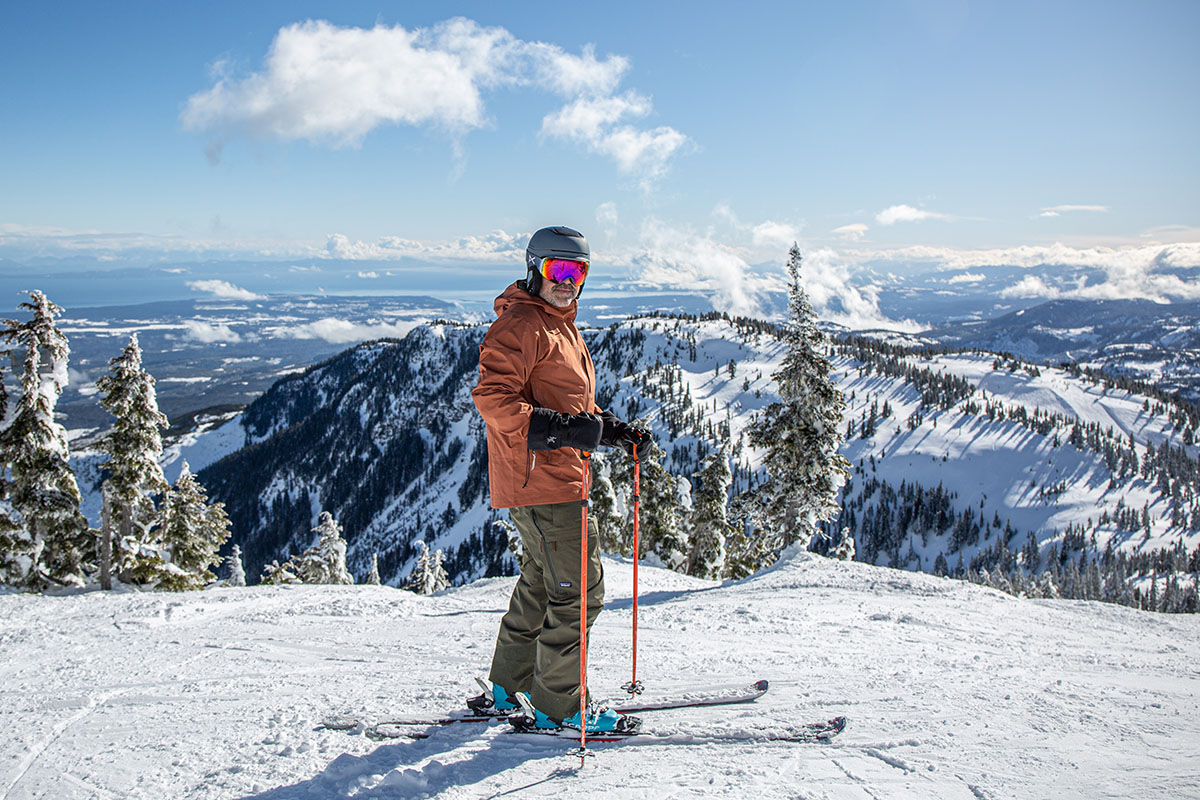
My only notable complaint has to do with the waist design: Along with a standard two-snap closure and zippered fly, the pants feature Velcro tabs at either side to dial in fit. I wish Patagonia had opted for a different material here—the Velcro tends to scratch against my skin whenever my shirt rides up. I certainly appreciate the ability to tighten the pants so that they stay securely in place (especially given their heft, which I cover below), but it’s a notable drawback from a comfort standpoint. The good news is that Patagonia included belt loops, meaning you can get the Velcro in a comfortable (read: non-abrasive) position and then add a belt to tighten things up.
While not insulated, the Storm Shift Pants' burly shell and thin tricot mesh lining did an admirable job of keeping me comfortable all season long. Paired with a thin (150g/m²) merino wool baselayer underneath, it'll keep you isolated from a frozen chairlift seat, and I managed to stay cozy down to around 5 degrees Fahrenheit. I should mention that I do run warm, but those at the opposite end of the spectrum can always add additional—or thicker—layers underneath (the accommodating fit makes it easy). It’s true that the lining in the pants is thinner than that of the matching Storm Shift Jacket, but I found it to be a just-right amount of protection for my legs. And the thick shell fabric helps considerably when wind is a factor. Even when our chairlift stopped in howling gusts and grew covered in a layer of ice, the pants effectively fended off the chill and kept me comfortable until we got moving again. 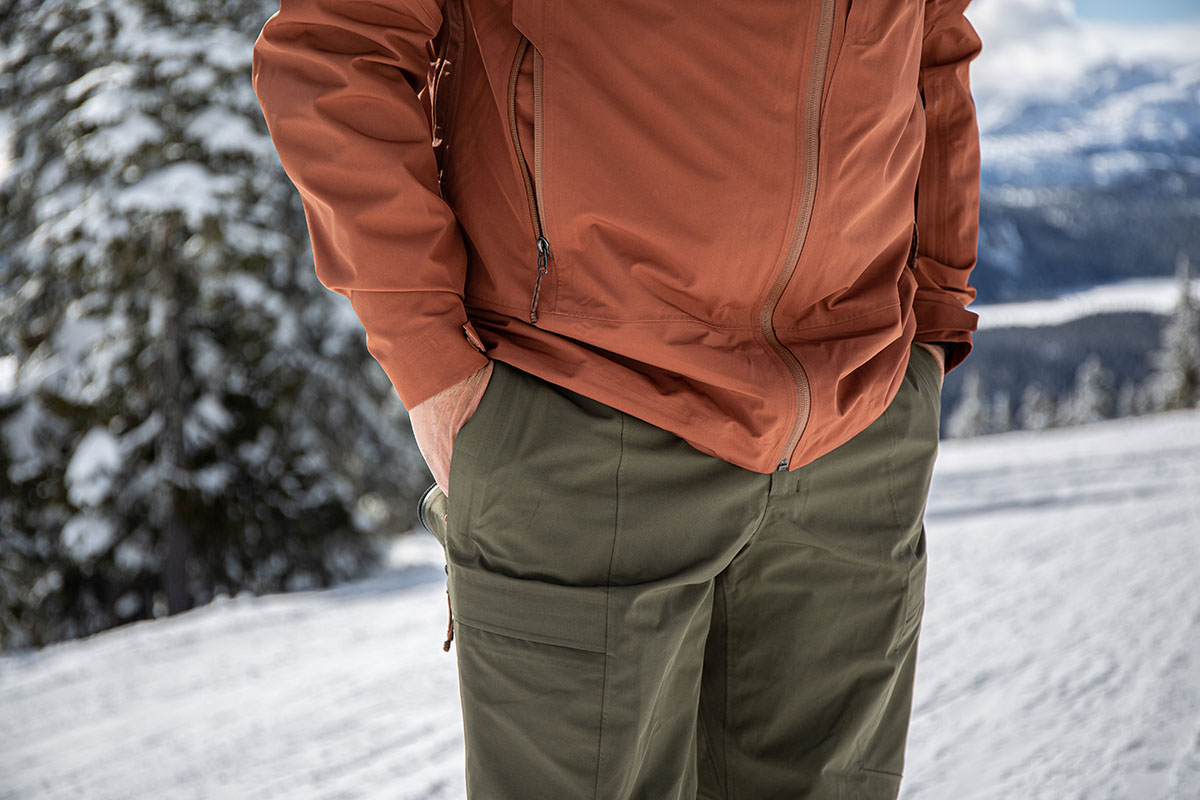
The Storm Shift Pants breathe well for a 2-layer design, but they wouldn’t be my first choice for sweat-inducing activities like spring touring. On the bright side, the hanging mesh/polyester lining allows for solid airflow, and you also get zippered, mesh-lined vents that run about 13 inches down the outer thighs for dumping excess heat (a nice upgrade from cheaper pants that have vents along the inner thigh). For reference, I’ve done a fair amount of bootpacking in the pants—including an unexpected slog up a long ski run after breaking a binding—and stayed perfectly comfortable in the cold (~5-degree Fahrenheit) temperatures.
Given my experiences thus far, I expect that I could even get away with wearing the pants on mellow tours, but I’d likely need to tweak my layering and rely heavily on the thigh vents. In my opinion, the Storm Shift Pants are best suited for cool to cold resort days when you won’t be working too hard. For even occasional touring, we’d step up to a lighter and more breathable 3-layer design like Black Diamond's Recon Stretch Pants.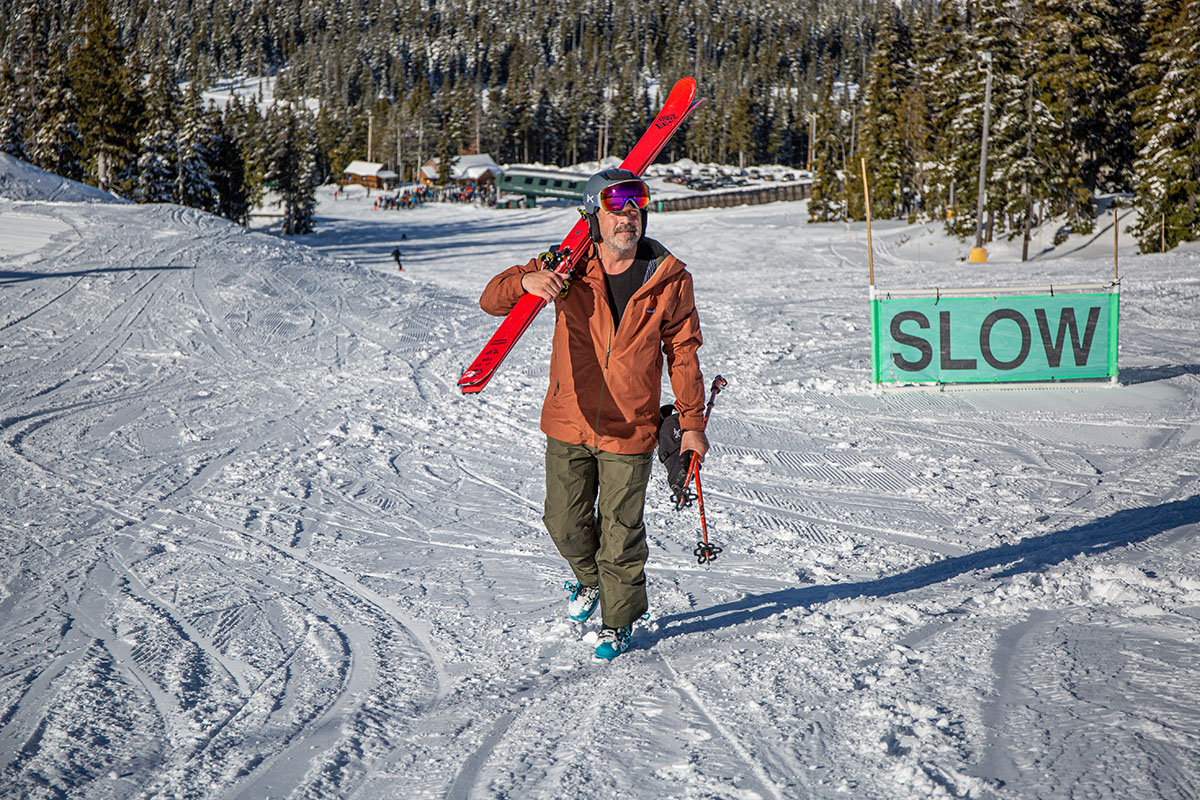
We’ve come to trust the Patagonia name when it comes to all-around quality, and the Storm Shift Pants didn’t disappoint. For starters, the shell fabric is noticeably thick at 150 denier (D) and has a very hardwearing and confidence-inspiring feel to match. Further, Patagonia included burly scuff guards at the inside of each cuff that protect against abrasion from sharp equipment like ski poles and edges. After considerable abuse, my pair is almost no worse for wear: The zippers are working flawlessly with no sticking or snagging, the tricot mesh lining has maintained its comfort and moisture-wicking abilities, and the outer shell has shrugged off everything I—and Mother Nature—have thrown its way. All told, I have no complaints from a build quality standpoint and expect the Storm Shift Pants to hold up very well over the long term.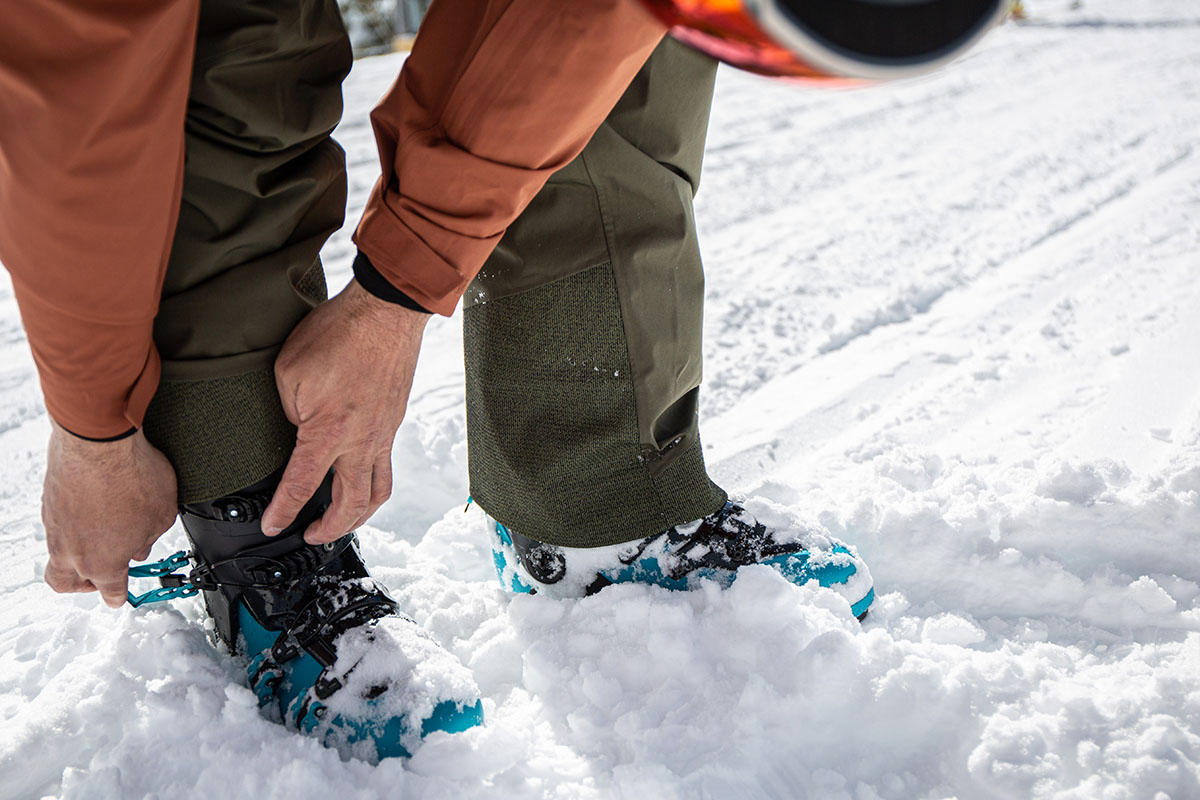
Clocking in at 1 pound 10.2 ounces for the men’s version, the Patagonia Storm Shift Pants are about average—if not slightly heavy—compared to other uninsulated 2-layer designs. For comparison, you can save some weight with Patagonia’s own Powder Town Pants (1 lb. 5.8 oz.), although you’ll make some concessions in weatherproofing (they use Patagonia’s in-house H2No membrane) and durability (the shell fabric is much thinner at 75D). Other alternatives including The North Face Freedom Pants (1 lb. 9.4 oz.) and Flylow Gear Patrol Pant (1 lb. 4.8 oz.) also check in lighter, as do many uninsulated 3-layer designs. The takeaway: The Storm Shift Pants aren’t a featherweight by any means and do feel relatively hefty on the slopes (plus, they tend to sag with the pockets full), but they’re far more hardwearing than most competitors, which I feel is a reasonable trade-off.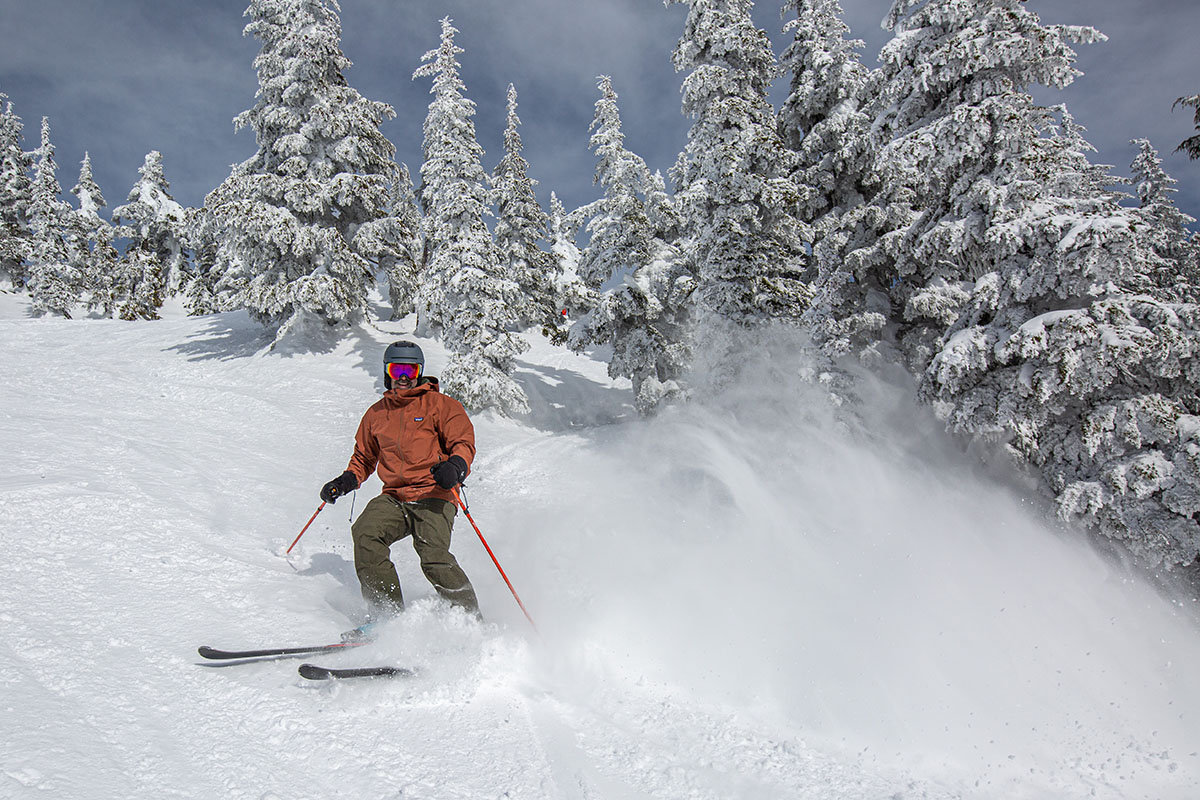
The Storm Shift Pants boast a four-pocket layout that includes two zippered handwarmer pockets and two zippered thigh pockets. The hand pockets are fleece-lined for comfort and have done a remarkable job of keeping my hands cozy between runs. They’re also large enough to stash a wallet, keys, or smartphone. The two thigh pockets, on the other hand, are not lined and sit rather snugly against the thigh, making for a tight fit with anything more than a wallet or low-profile pair of ski gloves stuffed inside. This isn’t a dealbreaker by any means—most resort-goers will opt to utilize their jacket pockets before filling their pant pockets to the brim—but it’s certainly worth noting if you’re someone who carries a lot of extras on the slopes. On the bright side, all the pockets boast watertight zippers, which are very trustworthy and have kept my valuables dry and protected throughout testing.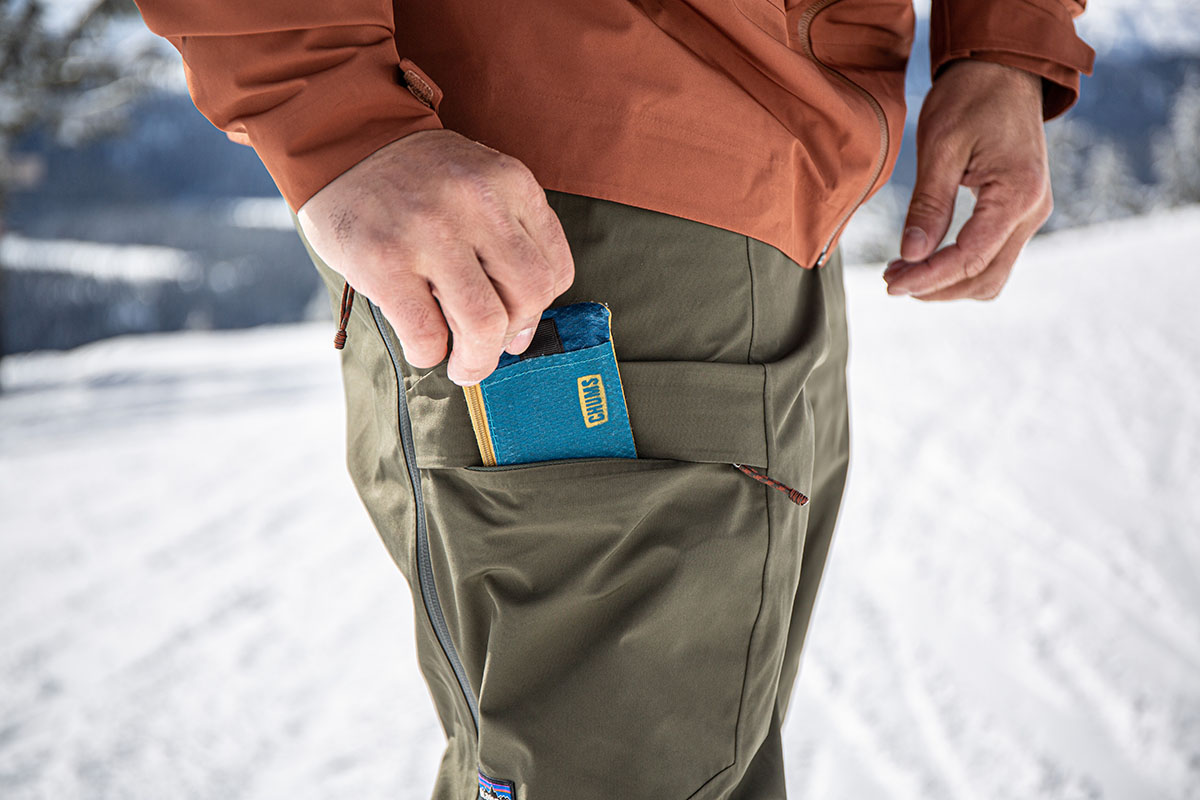
As mentioned above, the Patagonia Storm Shift Pants come equipped with generously sized outer thigh vents for dumping excess heat. For reference, we’ve found outer thigh vents to be much more effective than inner vents (which you get with The North Face’s Freedom Pants, for example) at promoting airflow while also minimizing bulk. The Storm Shift’s vents are also lined with tightly woven mesh, which helps prevent snow from entering but isn’t entirely foolproof in deep powder or in the event of a fall (although we haven’t had any issues to date and almost always ski with the vents closed).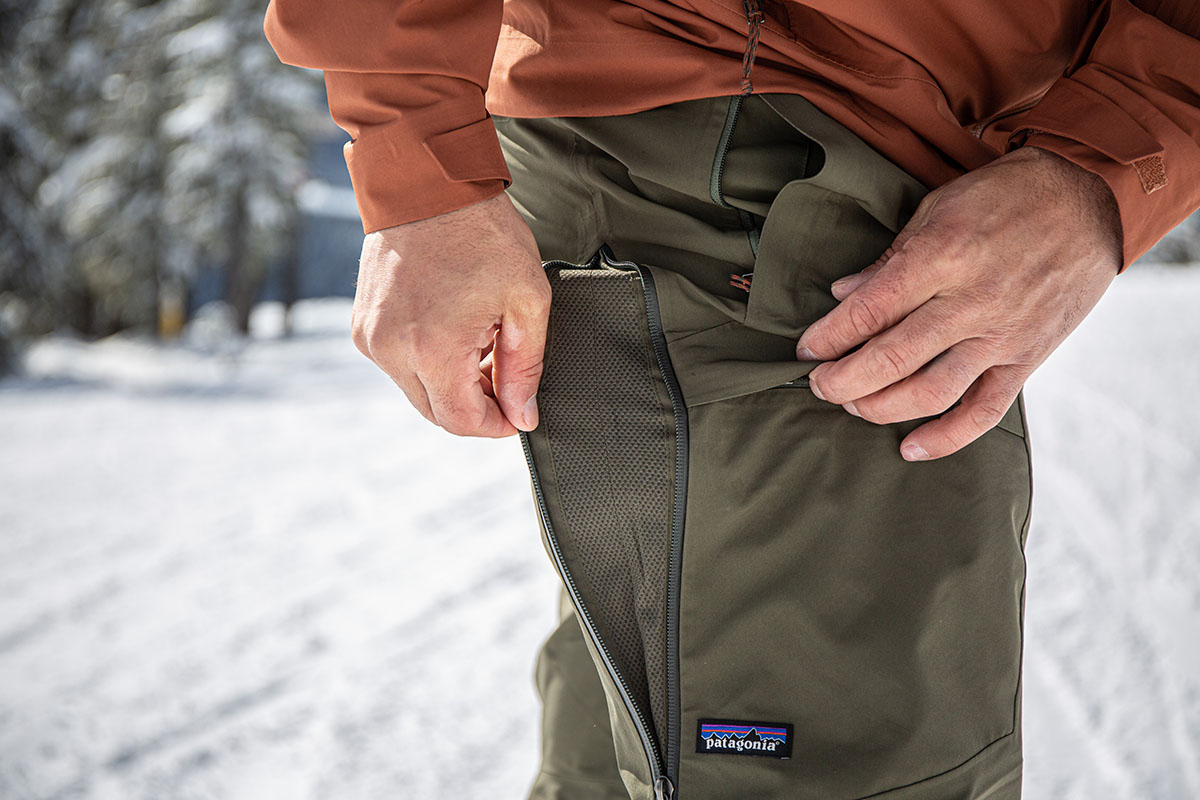
Rounding out the Storm Shift’s feature set are internal gaiters for keeping snow out of your boots and thick scuff guards to protect against abrasion at the inner ankles. As I covered previously, the gaiters have enough stretch to comfortably fit over boots and are secure enough that they stay put throughout the day. And the scuff guards have done their job—there are no noticeable scratches or snags from my ski edges, ski poles, or other sharp equipment despite frequent use. A final nice touch: The right cuff is equipped with a hidden Recco reflector, which will transmit your location to search and rescue personnel (if they have a Recco detector) in the event of an emergency.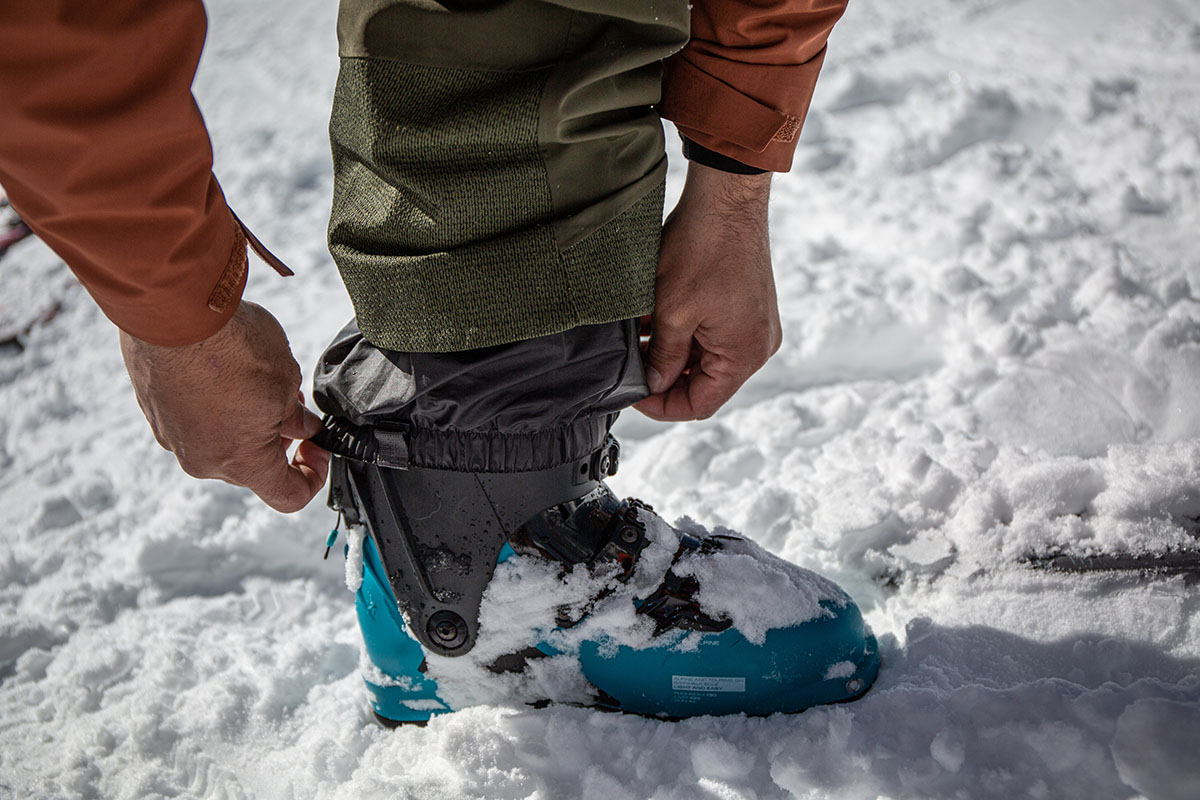
I’m typically a large in Patagonia pants, and that size in the Storm Shift was spot-on. The “regular” fit made it easy to add a mid- or heavyweight merino baselayer underneath without impacting mobility, and I was even able to wear my Patagonia Nano Puff Pants when temperatures really plummeted. I also found the 32-inch inseam (the pants are also offered in a 30-in. inseam length) to be perfect for my 6-foot frame—just long enough to maintain coverage over my boots when walking or bending down. And as I mentioned above, the waist is adjustable via Velcro tabs found at either side, which I don’t love but do add value for those who have some extra room in that area (adding a belt is another option). 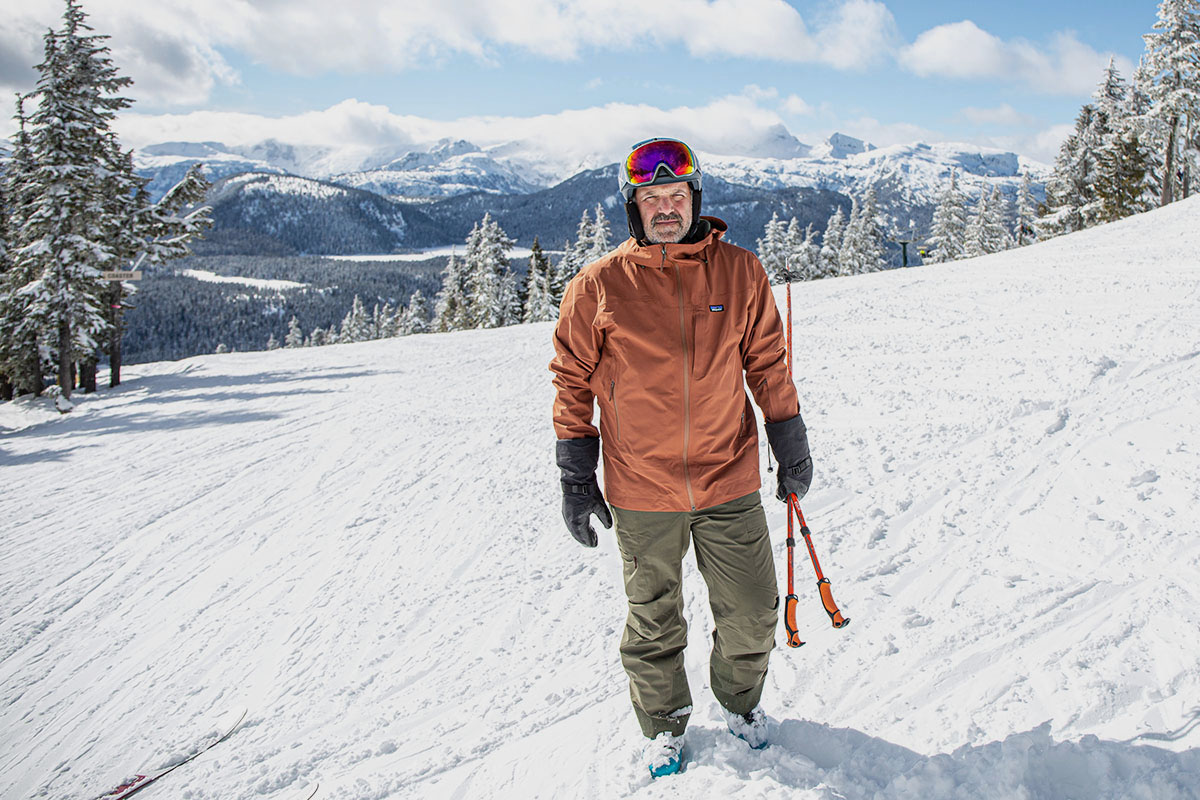
Patagonia is well known in the outdoor industry for their sustainable ethos, and the Storm Shift Pants clearly reflect that focus. First and foremost, the Gore-Tex construction is completely PFC-free—including the membrane, DWR finish, and fabric—meaning that it forgoes the use of perfluorocarbons, which are known as “forever chemicals” due to their inability to break down over time. Additionally, Patagonia utilized 100%-recycled polyester for both the shell and tricot mesh lining. Finally, the jacket is certified to the Fair Trade standard, which ensures that workers are compensated fairly and have access to programs like healthcare, childcare services, and more. Taken together, it’s another competitive effort from the brand and a good indicator of where the industry is headed.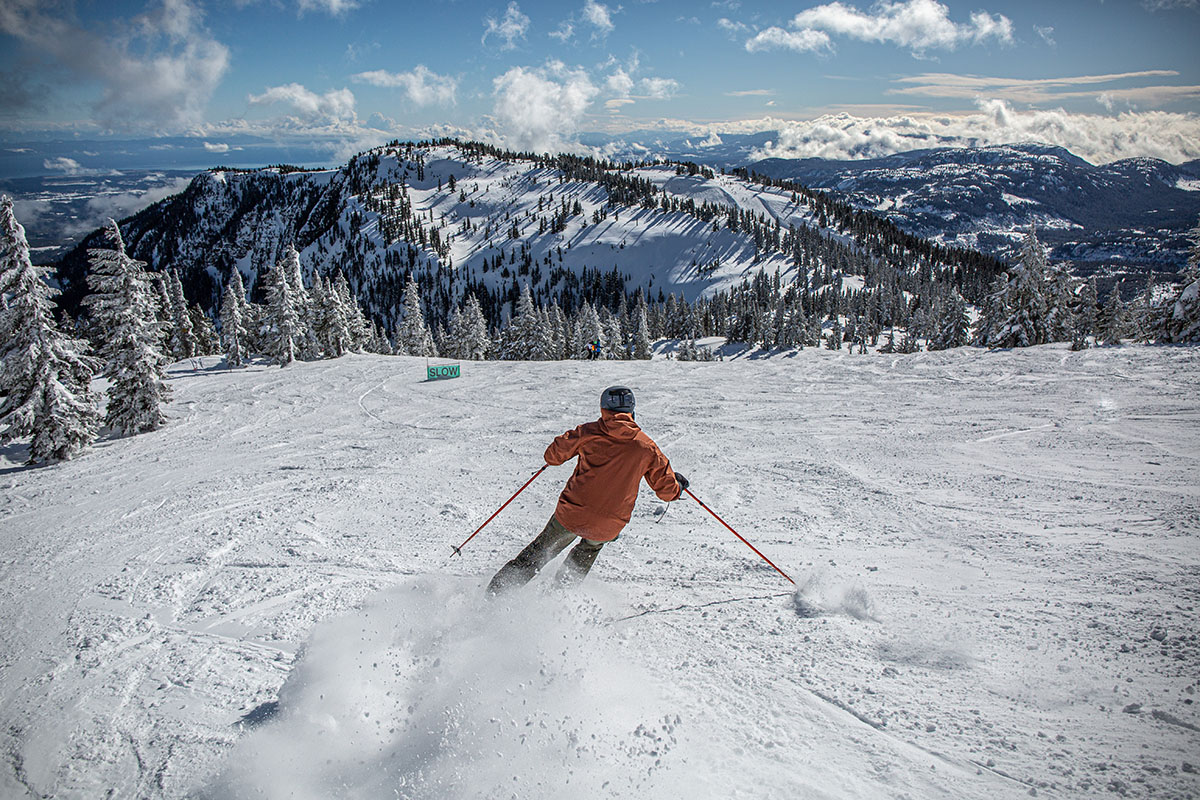
I tested the men’s Storm Shift Pants for this review, and they’re also offered in a women’s version for the same price. In parsing out the differences, the women’s Storm Shift Pants are a little lighter at 1 pound 8.3 ounces and sold in different colorways but otherwise largely identical to the men’s model. To complete your kit, Patagonia sells a compatible Storm Shift Jacket in both men’s and women’s styles (we recently reviewed the men's version), which retails for $499, uses the same 2-layer Gore-Tex build, has a slightly thicker tricot knit lining for a small bump in warmth, and boasts a powder skirt that attaches to the pants for integrated protection. Rounding out the collection is a kids’ version of the Storm Shift Jacket ($279), which uses the same 2-layer Gore-Tex construction and includes many of the same features as the adult models.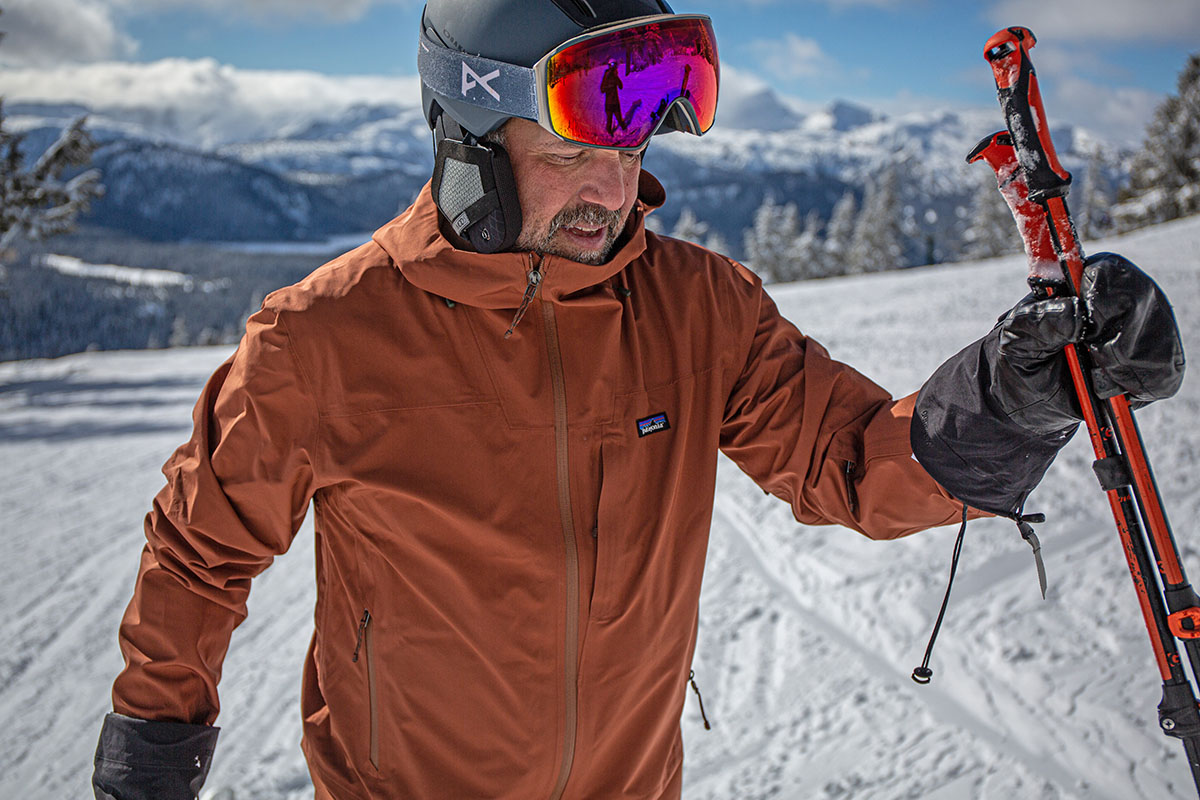
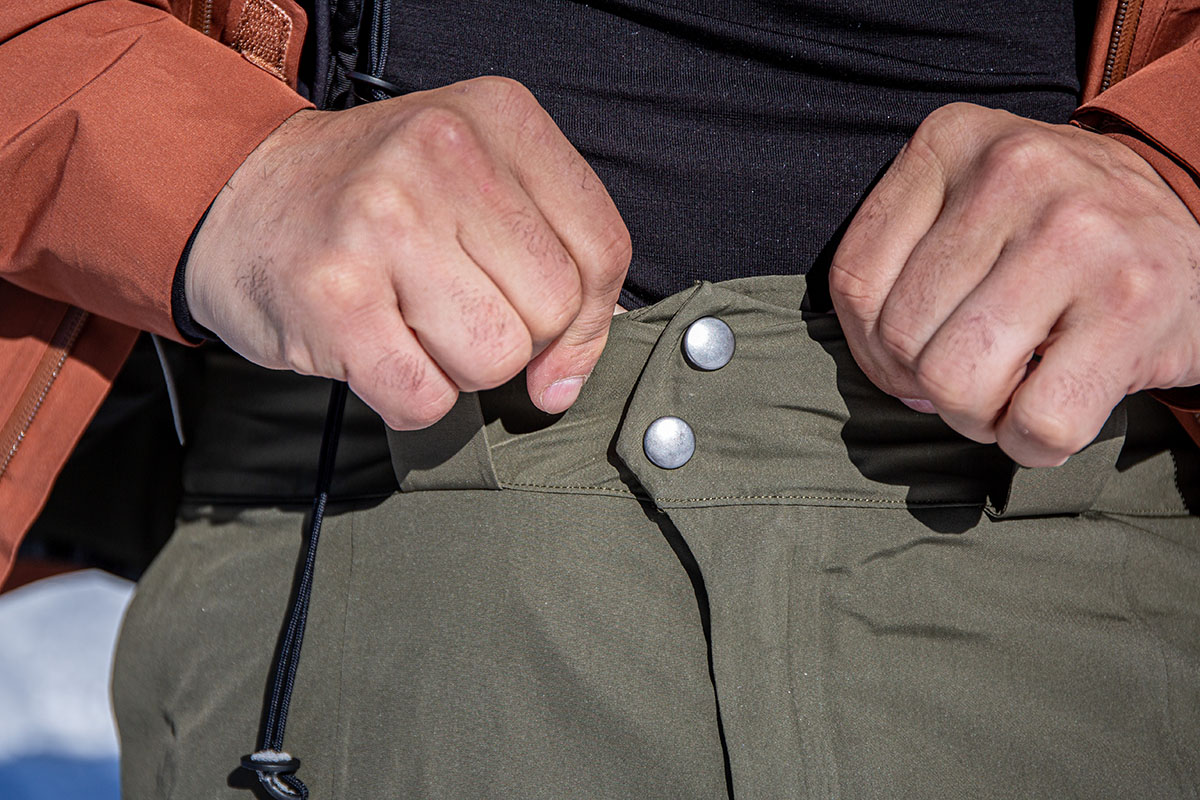
| Jacket | Price | Best For | Waterproofing | Fabric | Weight |
|---|---|---|---|---|---|
| Patagonia Storm Shift Pants | $399 | Resort | 2L Gore-Tex | 150D | 1 lb. 10.2 oz. |
| Patagonia Powder Town | $249 | Resort | 2L H2No | 75D | 1 lb. 5.8 oz. |
| Flylow Gear Patrol Pant | $200 | Resort | 2L polyester | Unavail. | 1 lb. 4.8 oz. |
| REI First Chair GTX Bibs | $269 | Resort | 2L Gore-Tex | Unavail. | Unavail. |
| Arc'teryx Sabre Pant | $600 | Resort/backcountry | 3L Gore-Tex | 80D | 1 lb. 6.8 oz. |
The Storm Shift is an impressively well-built and capable resort ski pant, but the $399 price tag will be a deterrent for some. Enter Patagonia’s own Powder Town Pants, which will save you a significant $150 while still checking all the boxes for most resort riders. Instead of Gore-Tex, the Powder Town uses Patagonia’s in-house H2No membrane (also 2-layer), which is impressively weather-worthy but lacks the truly bombproof feel of Gore-Tex. The Powder Town’s shell is also substantially thinner at 75D, although we haven’t had any durability issues to date. And weight-wise, the Powder Town gets the edge at 4.4 ounces less than the Storm Shift. Both jackets boast similar features including outer thigh vents, internal gaiters, scuff guards, four total pockets, and tricot linings, and the Powder Town also tacks on a microfleece panel at the seat for added comfort. In the end, both are high-quality resort designs with a keen attention to detail, and a final decision will come down to how you prioritize protection, durability, and price.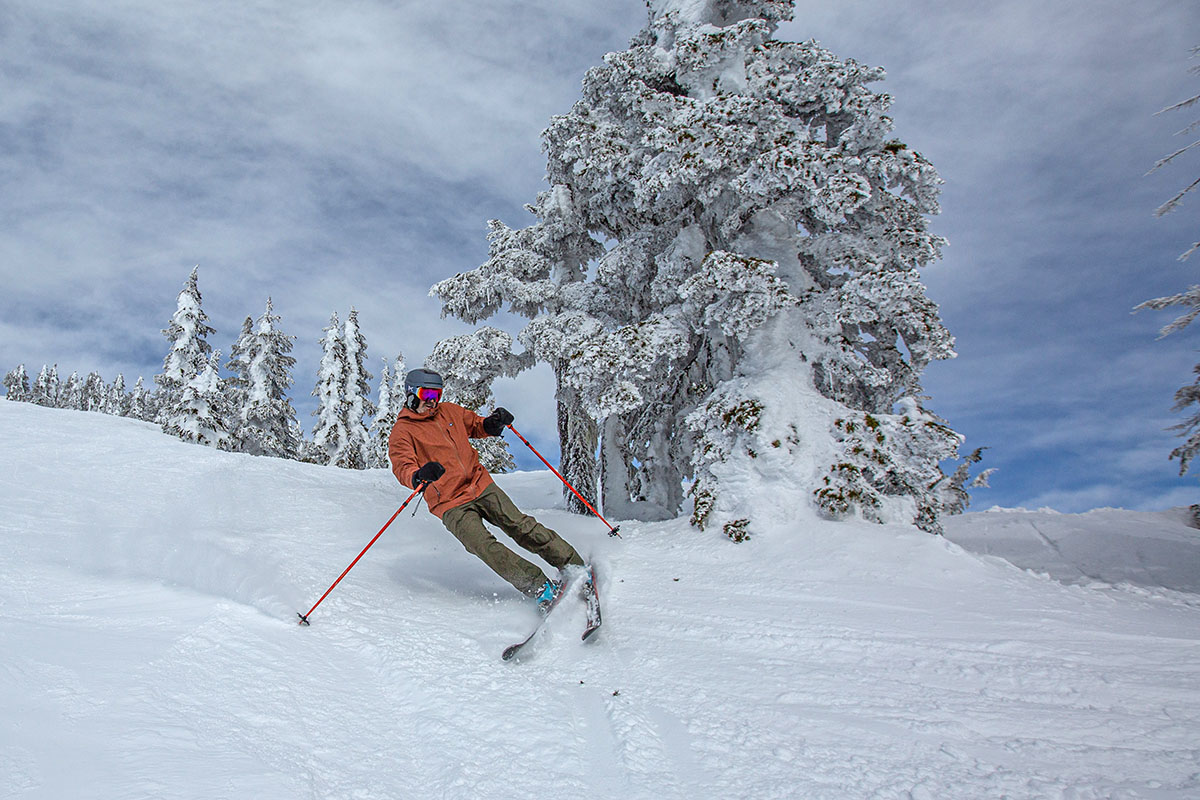 Moving away from Patagonia’s lineup, Flylow Gear offers an intriguing alternative to the Storm Shift in their Patrol Pant. For around half the cost of the Storm Shift, the Patrol features a similar 2-layer construction that’s lined with mesh for a nice balance between weatherproofing and breathability. Flylow also lined the seat with soft fleece, which is a boon for cold chairlift rides and snowboarders. And like the Storm Shift, the Patrol includes key features like powder gaiters, water-resistant zippers, belt loops, and a functional storage layout. The Flylow is also lighter at 1 pound 4.8 ounces, although the vents are shorter (10 in.) and located at the inside rather than outside of the leg, which we’ve found less effective at dumping heat quickly. In the end, the Patrol is a well-built alternative to the Storm Shift at a nice discount, but committed skiers will benefit from spending up for the more premium and fine-tuned Patagonia.
Moving away from Patagonia’s lineup, Flylow Gear offers an intriguing alternative to the Storm Shift in their Patrol Pant. For around half the cost of the Storm Shift, the Patrol features a similar 2-layer construction that’s lined with mesh for a nice balance between weatherproofing and breathability. Flylow also lined the seat with soft fleece, which is a boon for cold chairlift rides and snowboarders. And like the Storm Shift, the Patrol includes key features like powder gaiters, water-resistant zippers, belt loops, and a functional storage layout. The Flylow is also lighter at 1 pound 4.8 ounces, although the vents are shorter (10 in.) and located at the inside rather than outside of the leg, which we’ve found less effective at dumping heat quickly. In the end, the Patrol is a well-built alternative to the Storm Shift at a nice discount, but committed skiers will benefit from spending up for the more premium and fine-tuned Patagonia.
Next up is another 2-layer Gore-Tex design to consider, this time in bib form: REI Co-op’s First Chair GTX Bib Pants. Recently updated with Gore’s more sustainable expanded polyethylene (ePE) membrane, the First Chair offers similar protection to the Storm Shift for $130 less. The REI also tacks on helpful features like mechanical stretch for added mobility, a mid-height bib with adjustable straps and belt loops for dialing in fit, two-way thigh vents that double as a drop seat for bathroom breaks, a knit panel at the back for added comfort, and a tricot lining at the upper legs and inside the pockets for a bump in coziness and warmth. We also appreciate REI’s wide sizing selection—including dedicated short and tall options—although the fit is pretty generic, and it’s hard to match Patagonia’s attention to detail. But these are small complaints for an otherwise very well-rounded design, and the First Chair gets the clear edge in value. 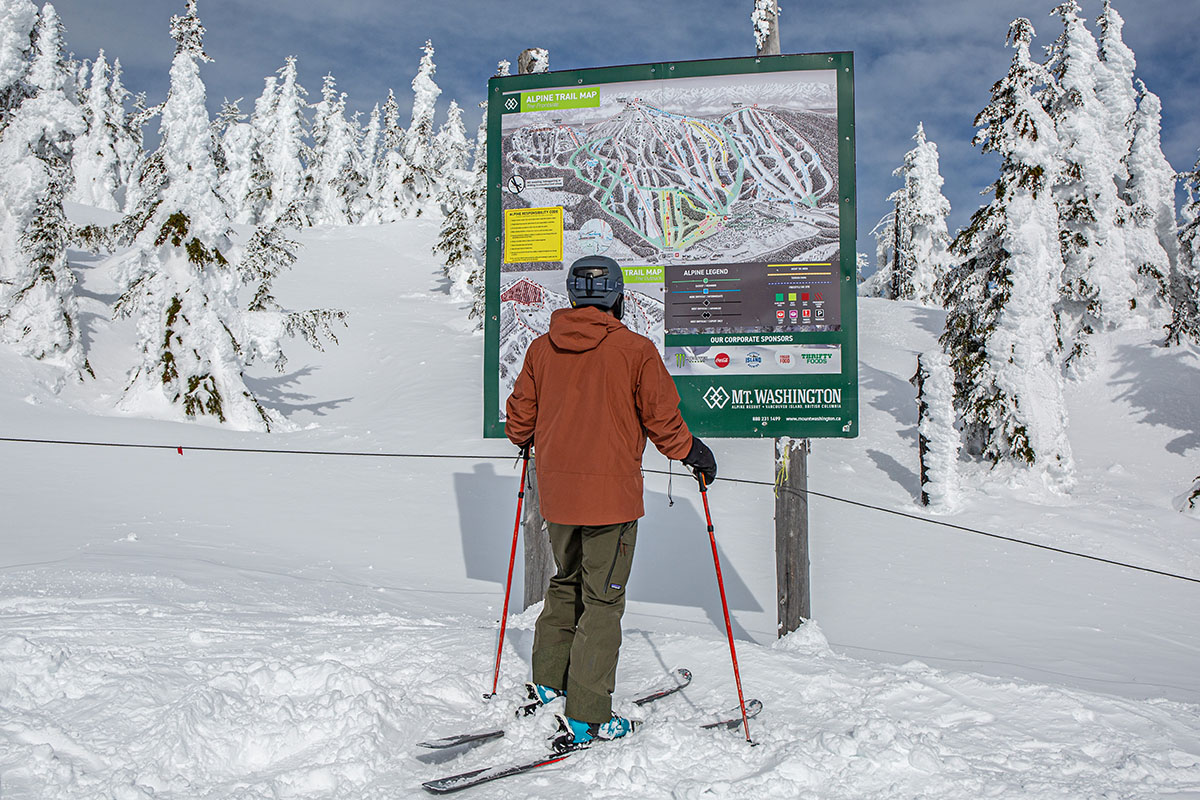
Finally, for riders who like to split their time between the resort and backcountry, it’s hard to beat Arc’teryx’s premium Sabre Pant. Right off the bat, we’ll address the steep price tag: The Sabre costs a whopping $200 more than the already-pricey Patagonia, but overall performance lines up well with the cost. For starters, you get an upgraded 3-layer Gore-Tex construction that’s a step up in breathability and all-out protection, as well as a weight savings of 3.4 ounces. The Sabre does use a thinner 80D shell fabric, but overall build quality is excellent, and the trade-off is a noticeably less bulky feel. The Sabre also boasts a softer brushed liner for a small boost in comfort and insulation (for more, see our in-depth Sabre Pant review). In the end, those who exclusively ski inbounds should stick with the cheaper Storm Shift, but the Sabre is our top pick for those who like to earn their turns on occasion.